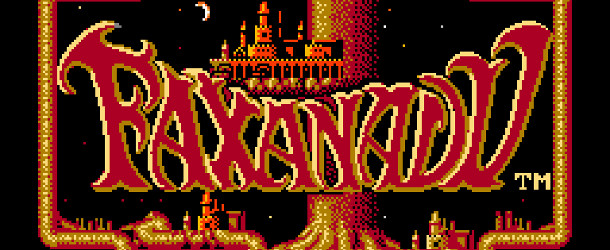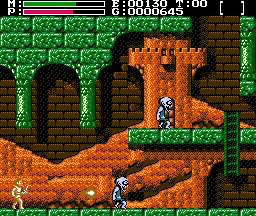 This classic GameCola article was originally published in September, 2007.
This classic GameCola article was originally published in September, 2007.
You know, for all the bad games I liked as a child, this was one that I expected to enjoy and never did. It’s actually a bit surprising to me, considering I liked a lot of similar games, and it’s not like the terrible translation had much of an effect back when I could barely read. What made this game so bad? Let’s review!
When you first start up Faxanadu, the developers trick you, getting you excited for the awesome game you’re supposedly about to play. All the effort that didn’t go into the rest of the game was put into this title screen. The title theme is probably the best song in the game (although that wasn’t hard), and while the picture may be a bit bland, it comes off as such in sort of an artistic manner. When you start a new game, you’re treated to what could be considered a cutscene—a rarity back in the days before SquareSoft’s discovery of the concept. All in all, the start of the game is pretty sweet.
Then, you get thrown into reality. It’s sort of like when Neo takes the red pill and discovers that the entire world around him is a lie created by evil machines. People in the ’90s thought that the NES was evil, but I never agreed with them until I played this game. How could I have been so deceived? The Matrix has me.
The graphics don’t seem quite so bad when you first start to play the actual game. What really kills you is the music. It’s that classic sort of sound typical of NES games—that is to say, not very good. On top of this, you’ll have to get used to the first five seconds of the town theme, since every building has different music. I guess that isn’t really uncommon in RPGs, but other games usually at least keep the music relatively consistent. In Faxanadu, you’re going from calm, melodic tunes to screeching bleeps that make your ears bleed in the next building. And if you can actually survive listening to any of the songs for more than thirty seconds, you’ll quickly realize that you haven’t been missing out on much before then. Most of the music isn’t even that long.
The graphics similarly degrade with play and are, at best, only par for the NES. The only thing that keeps this rating from being much lower is that the developers put in pictures of the people you’re talking to, which is something that didn’t become popular until the PlayStation era. However, at the same time, I don’t remember people being bright orange or pink and blinking really fast while they talk only to completely stop moving once they’ve finished. A lot of the people are also creepily symmetrical, so maybe they afforded it by only paying the artist to draw half of each picture. If you manage to get out of the first town without turning off the Nintendo, you’ll be treated to the brilliant, primary-color landscape of the outside world—which works to complement the brown-on-black town palette. Whatever redeeming value the tile composition and map design had, it was all destroyed by the preschool color scheme.
The rest of Faxanadu is just your average NES platform adventure game, complete with microscopic attack range, the ability to jump directly into pits, and special items that are about as effective as the DARE program. This comes with the added bonus of RPG features, such as incredibly slow, unskippable text that describes a story written by a Japanese art student and translated by the one guy at the company who’s taking night classes in English.
And, despite being an RPG, it comes with that favorite platformer method of continuing where you left off—the password. Maybe some of the Faxanadu staff came from the River City Ransom team, because in order to continue your game, you need to copy a string of 32 letters, numbers, and symbols. The only good thing about this is that you can look up the code to start at the end of the game with all of the best equipment, and you won’t have to actually play the rest in order to beat it.
Although I have enjoyed a number of poorly made games in my time, Faxanadu was never a game that I liked. Even the all-forgiving eye of a five-year-old—the same eye that was capable of forgiving such abominations as Air Fortress and James Bond Jr.—could not stand the sight of this game. It’s college textbook buy-back line in videogame form. Slow, full of people you can’t understand, and when you finally reach the end, it’s nowhere near as good as you’d hoped it would be.


